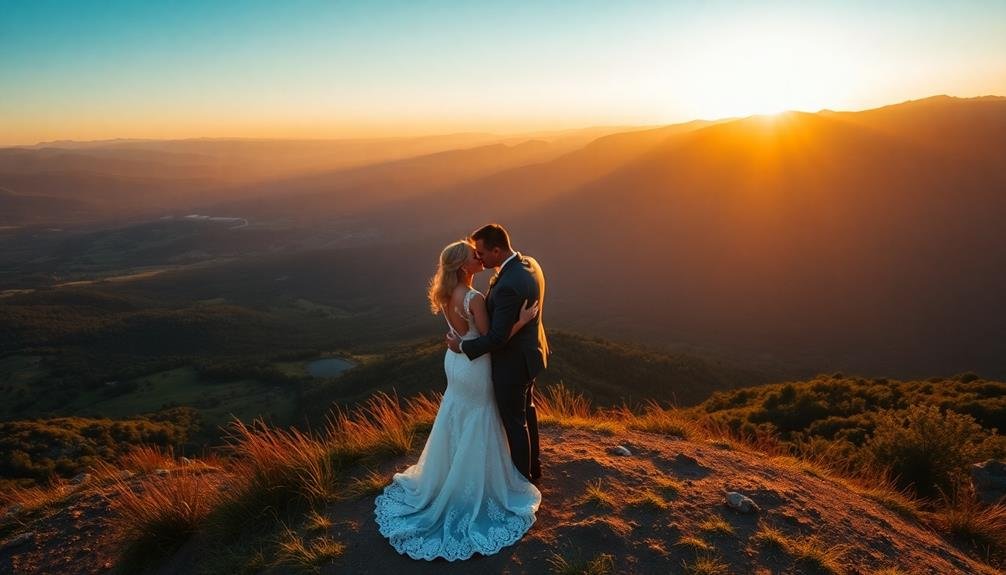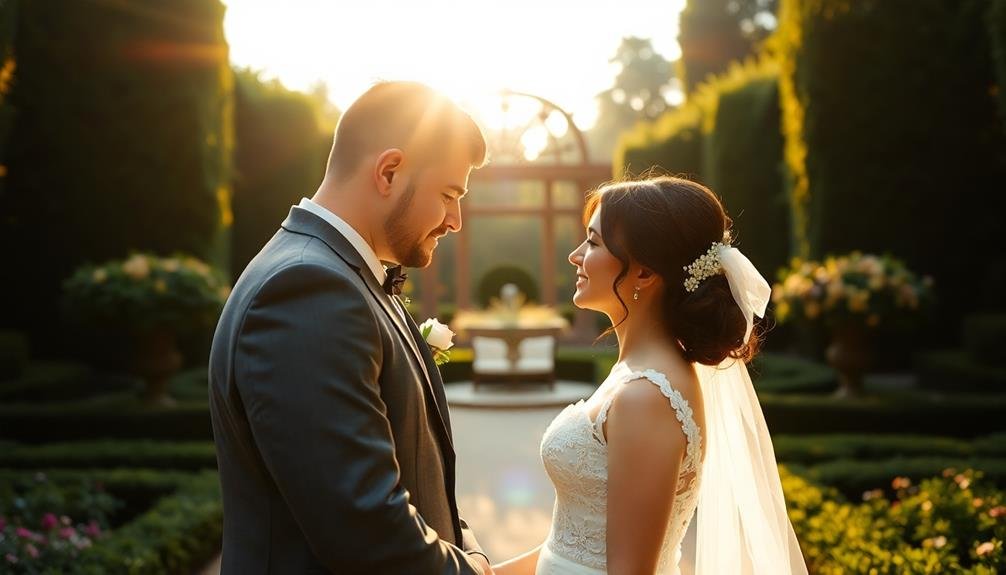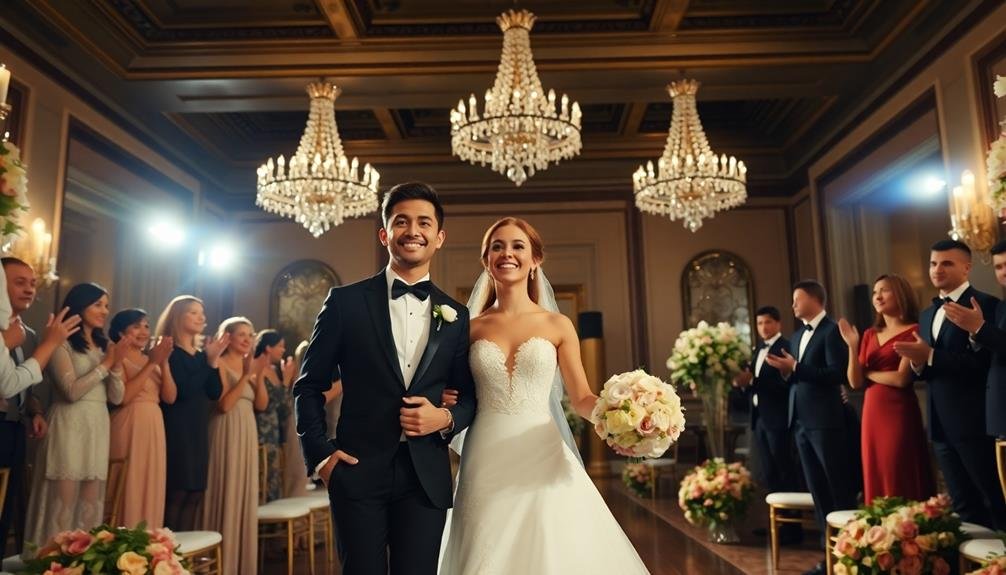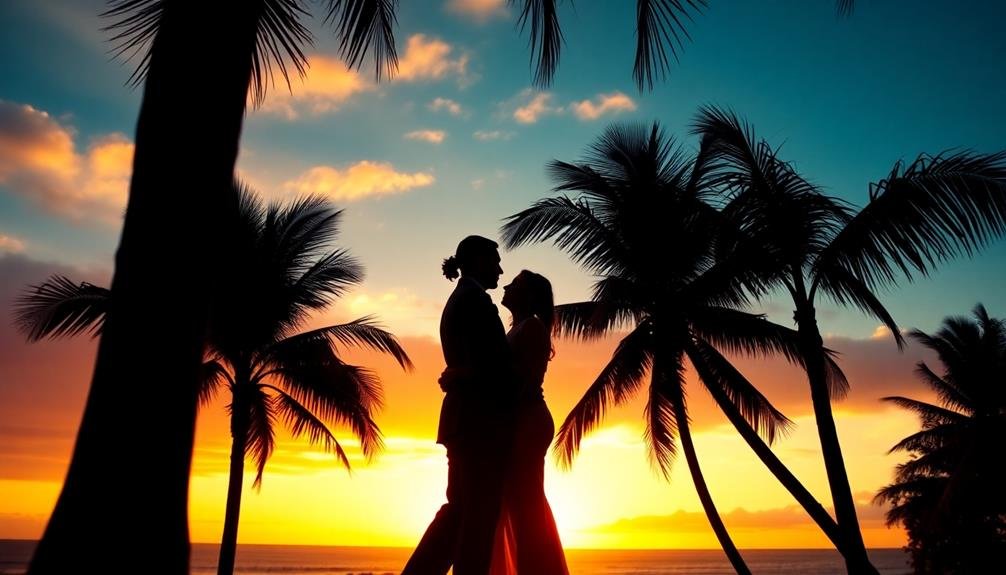Elevate your wedding videography with these cinematic camera moves. Start with a sweeping reveal to build anticipation, then capture the ceremony from overhead for a stunning perspective. Track the bridal procession smoothly, and use a drone for an establishing flyover. Create intimacy with a couple's first look orbit, and energize the reception with a dance floor crowd reveal. Add drama with a sunset portrait dolly zoom, and catch all the excitement in a high-angle bouquet toss shot. Finally, follow the grand exit from above for a memorable finale. These techniques will transform your footage into a mesmerizing visual story that couples will cherish.
Key Takeaways
- Sweeping reveal: Start with the camera pointed away, then pan or tilt to unveil the scene, creating anticipation and engagement.
- Smooth tracking: Use push-in, pull-out, side-tracking, and arc techniques for fluid, cinematic movement around subjects.
- Couple's first look orbit: Execute a full 360-degree circle around the couple using a stabilizer or gimbal for smooth movement.
- Sunset portrait dolly zoom: Combine dolly movement with lens adjustment to create a dynamic effect stretching the background.
- Aerial flyover: Utilize a drone to capture establishing shots of the venue and surrounding scenery, enhancing storytelling and context.
The Sweeping Reveal

With a graceful arc, the sweeping disclosure sets the stage for cinematic wedding footage. This dynamic camera move slowly uncovers the scene, creating anticipation and drawing viewers into the moment.
You'll want to use a stabilizer or gimbal to guarantee smooth movement as you execute this technique.
Start with your camera pointing away from the subject, then slowly pan or tilt to unveil the full scene. This works beautifully for capturing the bride's entrance, showcasing the venue, or introducing key moments like the first dance.
To maximize impact, consider the composition of your final frame and time your disclosure accordingly.
Vary your speed and direction to keep things interesting. A slow, horizontal sweep can build suspense, while a quicker vertical reveal might add energy to a celebratory moment.
Don't overuse this technique; save it for truly impactful shots.
Practice the sweeping disclosure before the big day to perfect your timing and movement.
Overhead Ceremony Shot

You'll want to capture the entire ceremony layout with an overhead shot to provide a stunning perspective for your wedding video.
To achieve this, you'll need a drone or a camera mounted on a tall monopod or jib arm.
Set up your equipment before guests arrive, ensuring you have the necessary permits and clearances for aerial shots if using a drone.
Capturing Full Ceremony Layout
A truly enchanting overhead shot of the ceremony layout can transform your wedding video from ordinary to extraordinary. To capture this cinematic perspective, you'll need to plan ahead and secure the right equipment. Consider using a drone or a tall monopod to achieve the desired height and angle.
Before the ceremony begins, position your camera directly above the venue's center. This vantage point allows you to showcase the entire layout, including the aisle, seating arrangements, and altar. As guests arrive, you can capture their movement and the gradual filling of seats, creating a dynamic time-lapse effect.
During the ceremony, use smooth, slow movements to pan across the scene. This technique helps viewers appreciate the scale and beauty of the event. Focus on key moments, such as the bride's entrance or the couple's first kiss, by zooming in slightly while maintaining the overhead perspective.
To add depth to your shot, incorporate foreground elements like hanging decorations or tree branches. These details can frame the scene and provide a sense of context.
Remember to adjust your camera settings to account for varying light conditions, especially if you're shooting outdoors.
Equipment and Setup Tips
For capturing an overhead ceremony shot, proper equipment selection and setup are vital. You'll need a camera capable of high-quality video, preferably with 4K resolution. Choose a wide-angle lens to capture the entire scene from above. A gimbal or stabilizer is essential for smooth, steady footage.
To achieve the overhead perspective, you'll need a tall, sturdy tripod or a specialized overhead rig. Make sure it's rated to support your camera's weight. If using a tripod, extend it to its maximum height and consider using a horizontal arm attachment for additional reach.
Set up your equipment well before the ceremony begins. Position it strategically to avoid obstructing guests' views while still capturing the entire scene. Test different angles to find the best composition that includes the couple, officiant, and key decorative elements.
Consider using a remote control or smartphone app to operate your camera from the ground. This allows you to make adjustments without climbing up and down repeatedly. If possible, have a second camera operator monitor the feed and communicate any necessary changes.
Lastly, always prioritize safety. Secure all equipment properly and be mindful of potential hazards like wind or uneven surfaces.
Bridal Procession Tracking

When capturing the bridal procession, you'll want to master smooth tracking techniques to create fluid, cinematic movement.
As you follow the bride, focus on framing the processional to showcase the full scope of the event, including the wedding party and guests.
Don't forget to capture emotional reactions from family members and the groom as the bride makes her grand entrance.
Smooth Tracking Techniques
Capturing the bridal procession with smooth, flowing movement can elevate your wedding video from ordinary to extraordinary. To achieve this cinematic effect, you'll need to master smooth tracking techniques. These methods will help you create seamless footage that draws viewers into the moment.
Start by investing in the right equipment. A stabilizer or gimbal is essential for maintaining steady shots while moving. Practice using it before the big day to guarantee you're comfortable with its operation.
Next, consider your footwork. Take slow, deliberate steps to minimize camera shake. Bend your knees slightly and keep your body relaxed as you move.
Here are four key smooth tracking techniques to incorporate:
- Push-in: Slowly move towards the subject, creating a sense of intimacy
- Pull-out: Gradually move away, revealing more of the scene
- Side-tracking: Move parallel to the subject, capturing different angles
- Arc: Curve around the subject, adding depth and dimension
Remember to anticipate the action and position yourself accordingly. By mastering these techniques, you'll capture stunning footage that truly showcases the beauty and emotion of the bridal procession.
Capturing Emotional Reactions
While tracking the bridal procession, the true magic lies in capturing the emotional reactions of everyone involved. You'll want to focus on the bride's expression as she walks down the aisle, but don't forget about the groom, family members, and guests. Use a combination of wide shots and close-ups to tell the complete story.
To effectively capture these emotions, consider using a gimbal or steadicam for smooth movement. As you track the bride, periodically pan to capture reactions from different angles. Remember to anticipate key moments and be ready to switch your focus quickly.
Here's a guide to help you capture emotional reactions during the bridal procession:
| Subject | Shot Type | Focus Area | Emotion to Capture |
|---|---|---|---|
| Bride | Close-up | Face | Joy, nervousness |
| Groom | Medium shot | Upper body | Awe, happiness |
| Parents | Wide shot | Full body | Pride, tears |
| Guests | Pan shot | Group reactions | Excitement, smiles |
Framing the Processional
Throughout the bridal procession, framing plays an essential role in creating a cinematic and visually appealing narrative. As you capture this pivotal moment, consider using a combination of wide, medium, and close-up shots to add depth and emotion to your footage.
Start with a wide shot to establish the setting and atmosphere, then gradually move in closer to capture the bride's entrance and her journey down the aisle.
To elevate your processional footage, try these cinematic techniques:
- Dolly shot: Use a slider or stabilizer to create smooth, lateral movements that follow the bride's progression.
- Steadicam follow: Walk alongside or behind the bride for an immersive, fluid perspective.
- Low-angle tracking: Position your camera low to the ground for a dramatic, upward-facing shot that emphasizes the bride's dress and bouquet.
- Crane or jib shot: If possible, incorporate a sweeping overhead shot to showcase the entire processional and venue layout.
Remember to anticipate key moments, such as the father giving away the bride or the groom's first glimpse of his partner.
Venue Establishing Flyover

A sweeping aerial shot sets the stage for your wedding film. To capture a venue establishing flyover, you'll need a drone equipped with a high-quality camera. Start by planning your flight path, ensuring you comply with local regulations and obtain necessary permissions.
Begin your shot from a distance, slowly approaching the venue. As you fly closer, gradually increase altitude to disclose the full scope of the location. Aim for smooth, steady movements to create a cinematic feel. Capture the surrounding landscape, showcasing the venue's unique setting.
Time your flyover during the golden hour for ideal lighting. Consider the venue's architectural features and incorporate them into your shot composition. Fly around the building to showcase different angles and perspectives.
For added drama, try a reveal shot by starting behind trees or buildings, then ascending to disclose the venue. Experiment with different speeds and altitudes to find the most visually appealing approach. Remember to maintain a safe distance from guests and structures.
Edit your flyover footage to match the pace and tone of your wedding film, using it to introduce the venue and set the mood for the entire video.
Couple's First Look Orbit

Moving from the grand scale of a venue flyover, let's focus on an intimate moment: the couple's first look. The orbit shot captures this emotional scene beautifully, adding depth and dimension to a vital wedding day moment.
As you circle the couple, you'll create a dynamic, cinematic feel that draws viewers into their experience.
To execute the perfect first look orbit:
- Set up your camera on a stabilizer or gimbal for smooth movement
- Begin with the couple facing each other, about 6-8 feet apart
- Start your orbit from behind one partner, moving slowly and steadily
- Complete a full 360-degree circle around them, capturing both faces
Keep your movements slow and controlled, allowing the emotion of the moment to shine through.
You'll want to maintain a consistent distance from the couple throughout the orbit. Consider using a wider lens to capture more of the surroundings and create a sense of space.
Reception Grand Entrance Pan

As the wedding party makes their grand entrance at the reception, you'll want to capture the entire group's energy and excitement.
Position yourself strategically to pan across the room, following the movement of each member as they're introduced.
Keep your focus on the newlyweds as they enter last, ensuring you've captured their beaming smiles and the guests' reactions in one smooth, cinematic sweep.
Capture Entire Wedding Party
Sweep across the reception venue with a smooth pan to capture the grand entrance of the entire wedding party. This cinematic move creates a sense of anticipation and grandeur, setting the tone for the reception festivities. As you execute this shot, keep your camera movement steady and controlled, using a tripod or gimbal for ideal stability.
To make the most of this cinematic technique, consider the following tips:
- Position yourself strategically: Find a spot that allows for an unobstructed view of the entrance and the entire reception area.
- Coordinate with the DJ: Sync your pan with the music and announcements to enhance the dramatic effect.
- Adjust your frame rate: Shoot at a higher frame rate (60fps or 120fps) for smoother motion when slowed down in post-production.
- Use a wide-angle lens: This will help you capture more of the scene in a single sweep.
As the wedding party enters, maintain a consistent pan speed to showcase each member. Focus on capturing their expressions and interactions with guests.
This shot not only documents the grand entrance but also sets the stage for the reception's energetic atmosphere, making it a vital element in your wedding videography repertoire.
Follow Newlyweds' Movement
The pinnacle of the reception's grand entrance unfolds as the newlyweds make their appearance. To capture this moment with cinematic flair, you'll want to execute a smooth pan that follows their movement.
Start by positioning yourself at the end of their entrance path, ensuring you have a clear line of sight. As the couple begins their walk, initiate a slow, steady pan that matches their pace. Keep them centered in the frame, adjusting your movement as needed.
Use a fluid head tripod or a gimbal for seamless motion. If possible, incorporate a slight crane movement, gradually lifting the camera as they approach to add dynamism.
Pay attention to the background, capturing the reactions of guests as the newlyweds pass by. This adds context and emotion to the shot. Consider using a wider lens to include more of the surroundings, but be prepared to zoom in for close-ups of the couple's expressions.
If there's music playing, try to time your pan with the rhythm for a more engaging visual. Remember, smooth and controlled movement is key to achieving that cinematic look that'll make this moment truly unforgettable in the final wedding video.
Dance Floor Crowd Reveal

Revealing the excitement of a packed dance floor can be a powerful moment in wedding videography. To capture this energy, you'll want to master the dance floor crowd reveal technique. This move involves starting with a close-up shot of a single dancer or couple, then smoothly pulling back to disclose the entire bustling dance floor.
To execute this move effectively, consider these key elements:
- Start with a tight shot: Focus on expressive faces or rhythmic movements.
- Use a stabilizer: Guarantee smooth motion as you pull back.
- Time it right: Coordinate with the DJ for a crescendo or beat drop.
- Frame the reveal: Consider the composition as you shift to the wide shot.
You can enhance this move by incorporating a slight elevation change. As you pull back, gradually raise the camera to provide a better view of the crowd. This technique works well with a slider or gimbal system.
Remember to keep your movements steady and deliberate. Practice this move beforehand to perfect your timing and framing. When executed well, the dance floor crowd reveal can be a showstopper in your wedding video, capturing the joy and energy of the celebration.
Sunset Portrait Dolly Zoom

As the golden hour approaches, capturing a stunning sunset portrait with a dolly zoom can add a touch of Hollywood magic to your wedding video. This technique, also known as the "Vertigo effect," creates a mesmerizing visual illusion by simultaneously zooming in while moving the camera backward, or vice versa.
To execute this shot, you'll need a dolly or slider and a zoom lens. Position the couple facing the sunset, then start with a wide-angle shot. As you zoom in, slowly move the camera away from the subjects. This creates a dynamic effect where the background appears to stretch while the couple remains the same size.
Here's a breakdown of the dolly zoom process:
| Step | Camera Movement | Lens Action | Effect |
|---|---|---|---|
| 1 | Set up dolly | Wide-angle | Establish shot |
| 2 | Move backward | Zoom in | Background stretches |
| 3 | Continue backward | Continue zooming | Intensify effect |
| 4 | Stop movement | Stop zoom | Dramatic final frame |
Remember to practice this move before the wedding day. It requires precise coordination between your physical movement and lens adjustment. When executed well, the dolly zoom creates a surreal, dreamlike quality that perfectly captures the romance of a sunset wedding portrait.
Bouquet Toss High Angle

Moving from sunset portraits to another iconic wedding moment, capturing the bouquet toss from a high angle can create an unforgettable shot. Position yourself on a balcony, staircase, or use a drone to get a bird's-eye view of the action. This perspective allows you to capture the entire scene, including the bride, the group of enthusiastic participants, and the flying bouquet all in one frame.
To nail this shot, you'll want to:
- Scout the location beforehand to find the best vantage point
- Use a wide-angle lens to encompass the entire scene
- Set your camera to a fast shutter speed to freeze the action
- Employ burst mode to capture multiple frames
As the bride turns her back to the crowd, be ready to start filming. Focus on her as she builds anticipation, then quickly pan to follow the bouquet's arc through the air.
Keep the frame wide enough to capture the reactions of the participants as they reach for the flowers. This high-angle shot not only provides a unique perspective but also allows you to showcase the energy and excitement of this traditional wedding moment in a visually striking way.
Grand Exit Aerial Follow

The grand exit aerial follow shot serves as a spectacular finale to your wedding video. This cinematic move captures the newlyweds' departure from a bird's-eye perspective, creating a sense of grandeur and closure. To execute this shot, you'll need a drone equipped with a high-quality camera and an experienced operator.
Begin by positioning the drone high above the exit point, guaranteeing you have a clear view of the couple and their surroundings. As they emerge, start the drone's descent, gradually lowering it while following their path. Maintain a steady speed and distance to keep the couple centered in the frame. You can add drama by slowly increasing the drone's altitude as the couple moves further away, revealing more of the landscape.
Consider the lighting conditions for this shot. If it's a nighttime exit, guarantee the area is well-lit or use the drone's built-in lights. For daytime exits, be mindful of harsh shadows and adjust your camera settings accordingly.
Remember to capture the guests' reactions and any send-off elements like sparklers or confetti. This aerial perspective will provide a unique and memorable conclusion to your wedding video.
Frequently Asked Questions
What Camera Equipment Is Essential for Achieving These Cinematic Moves?
You'll need a high-quality camera, stabilizer (like a gimbal), slider, tripod, and wide-angle lens. Don't forget a drone for aerial shots. These tools will help you capture smooth, cinematic footage for your video projects.
How Can Videographers Practice These Techniques Before a Real Wedding?
You can practice these techniques by filming mock weddings with friends, attending workshops, or shadowing experienced videographers. Set up rehearsals in various locations, experiment with different equipment, and review your footage to refine your skills.
Are There Any Legal Considerations When Using Drones for Wedding Videography?
You'll need to obtain proper licenses and follow local regulations for drone usage. Check FAA guidelines, secure necessary permits, and get the couple's consent. Don't fly over people, and respect privacy laws and venue restrictions.
How Do You Manage Battery Life for Equipment During Long Wedding Shoots?
You'll need to bring extra batteries and chargers for all your gear. Plan your shooting schedule strategically, swap batteries during breaks, and use power-saving modes. Consider investing in high-capacity batteries for critical equipment.
What Software Is Best for Editing and Enhancing These Cinematic Camera Moves?
You'll find Adobe Premiere Pro and DaVinci Resolve are top choices for editing cinematic footage. They offer powerful tools for color grading, stabilization, and motion effects. Final Cut Pro X is also excellent if you're using Mac.
In Summary
You've now got a powerful toolkit of cinematic camera moves to elevate your wedding videography. Remember, it's not about using every trick in the book, but choosing the right moves to enhance your couple's story. Practice these techniques, and you'll create stunning, emotional wedding films that stand out. Don't be afraid to experiment and develop your own signature style. With these moves mastered, you're ready to capture unforgettable wedding moments like a pro.

As educators and advocates for responsible drone use, we’re committed to sharing our knowledge and expertise with aspiring aerial photographers.




Leave a Reply